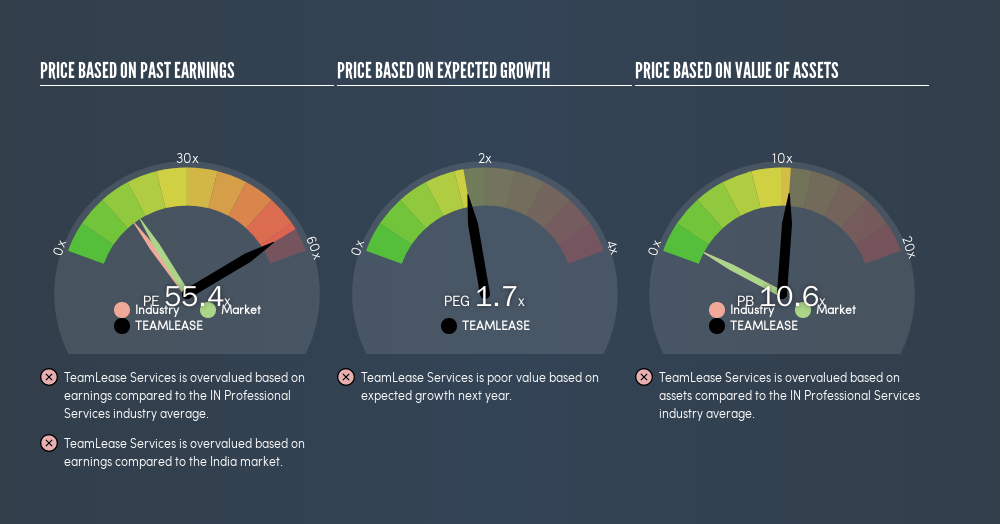- India
- /
- Professional Services
- /
- NSEI:TEAMLEASE
Why TeamLease Services Limited's (NSE:TEAMLEASE) High P/E Ratio Isn't Necessarily A Bad Thing

This article is written for those who want to get better at using price to earnings ratios (P/E ratios). We'll look at TeamLease Services Limited's (NSE:TEAMLEASE) P/E ratio and reflect on what it tells us about the company's share price. Based on the last twelve months, TeamLease Services's P/E ratio is 55.35. In other words, at today's prices, investors are paying ₹55.35 for every ₹1 in prior year profit.
View our latest analysis for TeamLease Services
How Do You Calculate TeamLease Services's P/E Ratio?
The formula for P/E is:
Price to Earnings Ratio = Price per Share ÷ Earnings per Share (EPS)
Or for TeamLease Services:
P/E of 55.35 = ₹3017.9 ÷ ₹54.52 (Based on the trailing twelve months to December 2018.)
Is A High P/E Ratio Good?
The higher the P/E ratio, the higher the price tag of a business, relative to its trailing earnings. That is not a good or a bad thing per se, but a high P/E does imply buyers are optimistic about the future.
How Growth Rates Impact P/E Ratios
Earnings growth rates have a big influence on P/E ratios. If earnings are growing quickly, then the 'E' in the equation will increase faster than it would otherwise. And in that case, the P/E ratio itself will drop rather quickly. And as that P/E ratio drops, the company will look cheap, unless its share price increases.
TeamLease Services saw earnings per share decrease by 1.0% last year. But over the longer term (5 years) earnings per share have increased by 36%.
Does TeamLease Services Have A Relatively High Or Low P/E For Its Industry?
One good way to get a quick read on what market participants expect of a company is to look at its P/E ratio. As you can see below, TeamLease Services has a much higher P/E than the average company (14.3) in the professional services industry.

TeamLease Services's P/E tells us that market participants think the company will perform better than its industry peers, going forward. Shareholders are clearly optimistic, but the future is always uncertain. So investors should always consider the P/E ratio alongside other factors, such as whether company directors have been buying shares.
Remember: P/E Ratios Don't Consider The Balance Sheet
The 'Price' in P/E reflects the market capitalization of the company. That means it doesn't take debt or cash into account. The exact same company would hypothetically deserve a higher P/E ratio if it had a strong balance sheet, than if it had a weak one with lots of debt, because a cashed up company can spend on growth.
Such spending might be good or bad, overall, but the key point here is that you need to look at debt to understand the P/E ratio in context.
TeamLease Services's Balance Sheet
Since TeamLease Services holds net cash of ₹2.9b, it can spend on growth, justifying a higher P/E ratio than otherwise.
The Verdict On TeamLease Services's P/E Ratio
TeamLease Services's P/E is 55.4 which suggests the market is more focussed on the future opportunity rather than the current level of earnings. The recent drop in earnings per share would make some investors cautious, but the healthy balance sheet means the company retains potential for future growth. If fails to eventuate, the current high P/E could prove to be temporary, as the share price falls.
Investors should be looking to buy stocks that the market is wrong about. People often underestimate remarkable growth -- so investors can make money when fast growth is not fully appreciated. So this freevisualization of the analyst consensus on future earnings could help you make the right decision about whether to buy, sell, or hold.
Of course, you might find a fantastic investment by looking at a few good candidates. So take a peek at this freelist of companies with modest (or no) debt, trading on a P/E below 20.
We aim to bring you long-term focused research analysis driven by fundamental data. Note that our analysis may not factor in the latest price-sensitive company announcements or qualitative material.
If you spot an error that warrants correction, please contact the editor at editorial-team@simplywallst.com. This article by Simply Wall St is general in nature. It does not constitute a recommendation to buy or sell any stock, and does not take account of your objectives, or your financial situation. Simply Wall St has no position in the stocks mentioned. Thank you for reading.
About NSEI:TEAMLEASE
TeamLease Services
Engages in human resource services to various industries in India and internationally.
Flawless balance sheet and undervalued.
Similar Companies
Market Insights
Community Narratives



